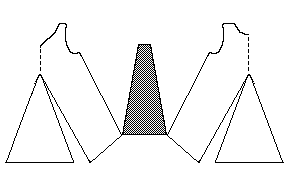
Pattern drawing based on a photograph in Nörlund. The shaded side gore is a guess on my part.

Pattern drawing
based on a photograph in Nörlund. The shaded side
gore is a guess on my part.
This is a child's garment made of front and back pieces with a center gore and side gores. There may have been sleeves at one time, but there is no sign of them. The bottom edge is finished with sewn on with long darning stitches passing backwards and forwards.
The neck is v-shaped. The back is long and almost has a train. The length from shoulder to hem is 51 cm (20"), the waist is 62 cm (24.4") in circumference, and the circumference of the bottom edge is 157 cm (61.8"). The armhole is 26 cm (10.2") around, and the neckhole is is 42 cm (16.5").
The material is a brown, fine textured four-shaft twill (i.e. 2/2 twill) frieze.
Maggie Forest made a separate examination of the materials of H33, H38, H39, H43, H45, H61, H65 and had the following to say:
The fabric is invariably 2/2 twill. The threads are less than a mm thick, the fabric wasn't fulled. The result is a slightly open weave, which would have held warmth like a modern knitted sweater. The gap between each thread would be about 1/3-1/2 mm - noticeable. The warp is spun with kemp hairs included for strength, the weft is just the soft under coat, and so the fabrics have a distinctive almost tweed-like appearance. The open weave and the twill weave would have made these fabrics drape like dreams. Despite the fact that they weren't terribly tight-fitted (although I have a thought on that too) they would have looked it, because the fabric would have clung quite closely.
The seams are just amazingly fine. They're done from the same thread as the fabric is woven from, and stitches are frequently only about 1mm long. There are places where Nörlund states that there is no hem, only a fold-over, but in fact there is a seam there, it's just so fine you need to look under the microscope. Leaning back, you can just see a shadow line from the seams, but the stitches are minute.
[The Greenlanders] used a stitch now known as priksom for a top stitch. It is a running stitch, but it goes through the fabric diagonally and ends up looking totally like a modern machine seam, with each stitch butting close to the next..
The tablet woven edge that is extant in the London material also appears in the Greenland material. A couple of the hoods have a quite wide edge, about 1.5 cm wide, done in this way, which gives a really distinctive looking edge with wide stitches on the back. Very tidy.
[Forest agrees with Robin Netherton's assertion that the Nörlund's pattern diagrams are flawed.] They really look nothing like it. This may be because he drew the diagrams before the first conservation, but for example, there really aren't those curves in the 39 gown.
The false seams were not used to add additional fit - they are even all the way through the garment.
This page was last modified 11 June 2003
Nörlund, Poul. "Buried Norsemen at Herjolfsnes: an archaeological and historical study." Meddelelser om Gronland: Udgivne af Kommissionen for ledelsen af de geologiske og geogrfiske undersogelser i Gronland. Bind LXVII. Kobenhavn: C.A. Reitzel, 1924.
Go to Tunic Page; Herjolsnes Site Page
Some Clothing of the Middle Ages -- Kyrtles/Cotes/Tunics/Gowns -- Herjolfsnes 61, by I. Marc Carlson, Copyright 1997 This code is given for the free exchange of information, provided the Author's Name is included in all future revisions, and no money change hands-